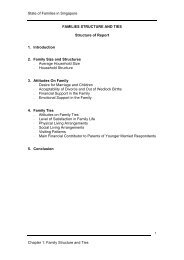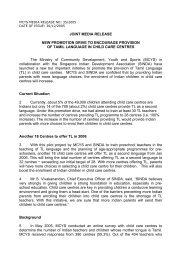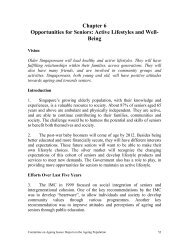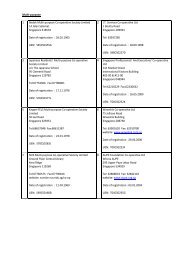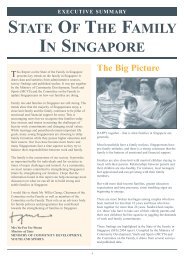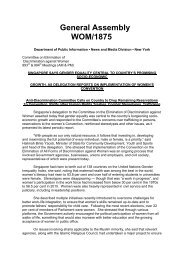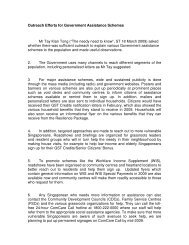Protecting Families from Violence: The Singapore Experience
Protecting Families from Violence: The Singapore Experience
Protecting Families from Violence: The Singapore Experience
- No tags were found...
Create successful ePaper yourself
Turn your PDF publications into a flip-book with our unique Google optimized e-Paper software.
1Foreword<strong>Protecting</strong> <strong>Families</strong> <strong>from</strong> <strong>Violence</strong>: <strong>The</strong> <strong>Singapore</strong> <strong>Experience</strong>For years, many have perceived family violence as a private familyaffair. However, the fact that the violence occurs in the family, anenvironment expected to be safe and protective, makes family violenceparticularly distressing.<strong>Singapore</strong>’s strategy in tackling family violence is to strengthen thefamilies affected by violence by enhancing the community support.Like many other social issues that we face, family violence is a complexphenomenon that is multifaceted. It requires responses <strong>from</strong> all sectorsof society to co-operate and collaborate in ensuring the safety andwell-being of families.I am happy to present this updated publication to you. You will findan overview of the trends and profile of family violence cases and therange of our services, programmes, research and public educationefforts. It also highlights the significant milestones and initiativesachieved so far in the area of family violence work in <strong>Singapore</strong>.Every family deserves the right to live without fear and the work tohelp families for whom violence exists is an ongoing one. By sharingour experience through this publication, we hope that the collectiveknowledge gained will help all of us to work in concert in achievingour shared objective of a violence-free environment for families.Mrs Yu-Foo Yee ShoonMinister of Statefor Community Development, Youth and Sports
2ContentChapter 1Chapter 2Chapter 3Chapter 4Chapter 5Chapter 6ReferenceIntroductionOverview of the Integrated Management ofFamily <strong>Violence</strong> in <strong>Singapore</strong>Trends and Research on Family <strong>Violence</strong>Services and Programmes for <strong>Families</strong>Public EducationSuccesses and ChallengesFlow Chart On <strong>The</strong> Management Of Family <strong>Violence</strong>CasesAcknowledgementsImportant Contact Details03071219222932333435
3Chapter 1:IntroductionFamily violence can have devastatingconsequences. When violence occurs athome, the impact is felt by everyone in thefamily. <strong>Singapore</strong> takes a serious view ofviolence in any form and seeks to foster aviolence-free environment for families throughmulti-agency collaboration.<strong>The</strong> legislation on family violence that cameinto effect in May 1997 provided the impetusfor a closer government and communitypartnership in reducing family violence.Arising <strong>from</strong> the legislative provision, a multiprongedapproach was formulated to identifyand help families affected by violence.This publication documents the <strong>Singapore</strong>experience in managing family violence byexamining the policy framework on familyviolence, the continuum of services andprogrammes in place to help victims recover<strong>from</strong> their trauma and perpetrators cease theirabusive behaviour, trends, research, andpublic education efforts to prevent violencein homes.What is Family <strong>Violence</strong>?In <strong>Singapore</strong>, the family is the basic unit ofsociety and the basis upon which policiesand programmes are formulated.Section 64 of the Women’s Charter defines‘family violence’ as the commission of any ofthe following acts:• Wilfully or knowingly placing or attemptingto place a family member in fear of hurt;• Causing hurt to a family member by suchact which is known or ought to have beenknown would result in hurt;• Wrongfully confining or restraining afamily member against his will; and• Causing continual harassment with intentto cause or knowing that it is likely tocause anguish to a family member.Under the law, a ‘family member’ is definedas ‘a spouse or former spouse, a child(including adopted and step children),parents, parents-in-law, sibling or any otherrelative or incapacitated person whom theCourt regards as a family member.’<strong>The</strong>re are strict laws in <strong>Singapore</strong> againstfamily violence. Where incidences of violencehave occurred in the home, the communityand the government will step in to provideprotection to the victims and to address theoffending behaviour.Legal Protection for <strong>Families</strong>Several key pieces of legislation underlie themanagement of family violence in <strong>Singapore</strong>.<strong>The</strong> cornerstone of the legislative provisions isthe Women’s Charter.
4 Chapter 1: IntroductionWomen’s Charter<strong>The</strong> protection under the Women’s Charter isaccorded to all who are vulnerable, regardlessof gender. In 1996, amendments were madeto the Women’s Charter to give greaterprotection to family members against violence.<strong>The</strong> amendments included the widening ofthe definition of family members beyondspouses and children, as well as the definitionof family violence to include emotional andpsychological harm. At the same time,amendments were made to enable the Court toissue a Personal Protection Order (PPO) on theprinciple of “balance of probability” insteadof “beyond reasonable doubt” in situationswhere violence has occurred or is likely tooccur. <strong>The</strong>se amendments have encouragedvictims to seek protection and help.Did you know?If a person is under 21 yearsold, or is unable to apply for aPersonal Protection Order dueto mental or physical disability,ill-health or old age, a guardian,relative, caregiver, or anyother person appointed bythe Minister may apply for theOrder on his behalf.One of the options under the PPO is theDomestic Exclusion Order (DEO), which grantsthe right of exclusive occupation of the sharedresidence or a specific part of the sharedresidence, to the protected person.If there is imminent danger of family violenceagainst a victim, the Court can also issue anExpedited Order (EO) to be served on theperpetrator under Sections 66 and 67 of theWomen’s Charter. This is a temporary PPOgranted in the absence of the perpetrator. Itis effective 28 days <strong>from</strong> the date that it wasserved to the respondent or till the first courthearing, whichever is earlier.<strong>The</strong> aim of the PPO is to restrain the perpetrator<strong>from</strong> using family violence. Any person whowillfully breaches the Protection Order orExpedited Order is liable to be fined up toS$2,000 or be imprisoned for up to 6 months,or both. In the case of a second or subsequentconviction, the person is liable to be fined upto S$5,000 or to be imprisoned up to 12months, or both.<strong>The</strong> section 65(5)(b) of the Women’s Charterempowers the Court to mandate perpetrators,victims and other family members to attendcounselling. <strong>The</strong> mandatory Counselling Order(CGO) is often issued together with a PPO.This order is meant to help the perpetrator stophis abusive behaviour. <strong>The</strong> Order can also begiven to a victim and other family members(including children) to support and protectthem <strong>from</strong> violence. Non-compliance with theorder can constitute contempt of the Court.Clients who are given CGOs will participatein the Mandatory Counselling Programmerun by various social service agencies in thecommunity.Penal CodeIn cases where the perpetrator has causedsubstantial physical hurt to the victim(s), chargesmay be brought against him under the PenalCode and an arrest made based on thosecharges. Under the Penal Code, the followingconstitute seizable offences:• Voluntarily causing grievous hurt wherebygrievous hurt is defined by permanentprivation or impairment of sight, hearing,member or joint, permanent disfiguration
Chapter 1: Introduction5of the head or face, fracture or dislocationof a bone, emasculation, or any hurt whichendangers life or which causes the suffererto be in severe bodily pain for 20 days orunable to follow ordinary pursuits.Children and YoungPersons ActChildren can also be victims of family violence.<strong>The</strong> Children and Young Person’s Act (CYPA)has legal provisions for the protection ofchildren and young persons against abuse,neglect and exploitation. <strong>The</strong> CYPA definesa child as one who is below 14 years of ageand a young person as one who is aged <strong>from</strong>14 to below 16 years old. Child abuse is“any act of omission or commission by a parentor guardian which would endanger or impairthe child’s physical or emotional well-being,or that is judged by a mixture of communityvalues and professionals to be inappropriate.”Child abuse may be in the form of physicalabuse, neglect, sexual abuse, and emotionalor psychological abuse. Psychological abusewas legally recognised as a form of abusethrough amendments to the CYPA in 2001.Under the CYPA, any act of child abuse orneglect, or behaviours that potentially exposethe child or young person to abuse and neglect,are offences punishable under the law. <strong>The</strong>penalties for such an offence include prisonterms of up to four years; fines not exceedingS$4000; or both imprisonment and fines. Inthe event that the child or young person dies, thepenalties include imprisonment of up to sevenyears; fines not exceeding S$20,000 or bothimprisonment and fines. For more informationon protecting children in <strong>Singapore</strong>, pleaserefer to the publication on “<strong>Protecting</strong> Childrenin <strong>Singapore</strong>” by the Ministry of CommunityDevelopment, Youth and Sports, October2005.<strong>The</strong> Maintenance ofParents Act<strong>The</strong> Maintenance of Parents Act providesrecourse to the elderly who are unable tomaintain themselves financially, by obtainingfinancial maintenance <strong>from</strong> their children. <strong>The</strong>Tribunal for the Maintenance of Parents has thejurisdiction to hear and determine the outcomesof all applications made under this Act.Any person domiciled and resident in<strong>Singapore</strong>, 60 years and above and unableto maintain himself adequately can claimmaintenance <strong>from</strong> their children, who arecapable of supporting him but are not doingso. A person below 60 years may also applyif the Tribunal is satisfied that he is suffering<strong>from</strong> infirmity of mind or body or for specialreasons which prevents him or makes it difficultfor him to maintain himself.Regional andInternationalConventions<strong>Singapore</strong>’s legislation for the protectionof women against violence are in line withtwo regional and international human rightsconventions which <strong>Singapore</strong> is party to,namely the United Nations Convention onthe Elimination of All Forms of DiscriminationAgainst Women (UN CEDAW) and theASEAN Declaration on the Elimination of<strong>Violence</strong> Against Women (DEVAW).UN Convention on the Elimination of All Formsof Discrimination Against Women (CEDAW)<strong>Singapore</strong> ratified CEDAW, a human rightstreaty for women, on 5 October 1995. Itdefines how equality between men and
6 Chapter 1: Introductionwomen can be achieved and what constitutesdiscrimination. CEDAW came into force for<strong>Singapore</strong> on 4 November 1995.<strong>The</strong> principles regarding the equality of menand women have been in place prior to<strong>Singapore</strong>’s accession to the Convention in theConstitution of <strong>Singapore</strong>. Legal provisions forthe protection of women against violence as inthe Women’s Charter support our obligationsunder CEDAW.ASEAN Declaration on the Elimination of<strong>Violence</strong> Against Women (DEVAW)<strong>Violence</strong> against women is a priority concernidentified by the ASEAN Committee on Womenof which <strong>Singapore</strong> is a member. <strong>The</strong> ASEANForeign Ministers signed the Declaration attheir 37th Meeting in Jakarta, June 2004. <strong>The</strong>Declaration commits ASEAN member countriesto implement and monitor commitments madeto eliminate violence along eight areas offocus. <strong>The</strong>y arei) research;ii) response mechanisms for survivors andperpetrators;iii) gender mainstreaming;iv) law reform;v) empowerment of women;vi) preventive measures;vii) regional collaboration; andviii) strengthening collaborations with non-profitorganisations.In this regard, <strong>Singapore</strong>’s policy framework,services and programmes are accorded to allwho are vulnerable or at risk of abusive familyrelationships.
7Chapter 2:Overview of the Integrated Management ofFamily <strong>Violence</strong> in <strong>Singapore</strong>In protecting families, <strong>Singapore</strong> aims to fulfillour obligations and roles through two policypillars:i) Multi-disciplinary and integratedpartnership; andii) Empowering victims and perpetrators.Multi-Disciplinary andIntegrated PartnershipFamily violence is a multi-faceted andprotracted problem which requires a multidisciplinaryand integrated approach.This requires a close partnership betweenthe government and community to reducefamily violence. While policies providethe framework for operation, inter-agencycoordination and communication are theessential elements which enable the systemto run well.Victims of family violence are not alonein dealing with violence in the home. Acorollary of the multi-disciplinary frameworkis what has been termed the “ManyHelping Hands” approach. Thisapproach underlies the social service deliverymechanism and espouses the principle that thevarious agencies, including the government,the community and families, should worktogether in partnership to tackle social issuesin <strong>Singapore</strong>.<strong>The</strong> Ministry of Community Development,Youth and Sports (MCYS) is the lead agencyin <strong>Singapore</strong> for supporting families at risk orin distress. MCYS plays a key role in chartingthe policy and service delivery frameworksfor the management of family violence.It coordinates and works in partnershipwith key ministries, the police, healthcareprofessionals and social service providers toprovide comprehensive and effective servicesfor those affected by violence.Central to the success of any policy is theeffectiveness of its implementation. In thisrespect, because of a high level of governmentand community commitment, <strong>Singapore</strong> hasbeen able to realise its policy intentions in themanagement of family violence. MCYS andits partners have developed various platformsfor policy implementations through:i) Implementing the “Many Helping Hands”approach; andii) Ensuring professional competency.Implementing the“Many HelpingHands” ApproachA key platform for the “Many HelpingHands” approach is the Family <strong>Violence</strong>Dialogue Group, which is headed jointly
8Chapter2: Over view of the Integrated Management ofFamily <strong>Violence</strong> in <strong>Singapore</strong>by MCYS and the <strong>Singapore</strong> Police Force. <strong>The</strong>Dialogue Group comprises the Family Court,<strong>Singapore</strong> Prisons Service, Ministry of Health,Ministry of Education, the National Council ofSocial Service, and social service agencies.<strong>The</strong> Dialogue Group was established toprovide a platform for the various agenciesto jointly set strategic policy frameworks andto enhance services for families who areaffected by violence. At the same time, thismulti-agency dialogue group collaborates onpublic education efforts aimed at preventingfamily violence and facilitates work processesamongst the agencies.<strong>The</strong> National Family <strong>Violence</strong>Networking System was establishedin 1996 to put a tight network of supportand assistance into place. This systemlinks the Police, hospitals, social serviceagencies, the Courts and MCYS into sixgeographical regions for closer collaborationand networking. <strong>The</strong> island-wide networkingsystem provides multiple access points forvictims to obtain help.To enhance networking amongst the manycommunity partners, regular regionalmeetings are held. <strong>The</strong>se meetings hostedby Police Land Divisions enable partners toimprove operational procedures and providecoordinated assistance to families. <strong>The</strong>enhanced police-social worker collaborationhas resulted in significant achievements, suchas the training of Police officers to betterunderstand and handle family violencecases, and increased public education tobuild awareness of the assistance available<strong>from</strong> Family Service Centres for victims andperpetrators. In their efforts to generategreater awareness, the Police and MCYShave reached out to faith-based organisationsand schools through various platforms andinitiatives.On an annual basis, MCYS and the <strong>Singapore</strong>Police Force co-organise the NationalFamily <strong>Violence</strong> NetworkingSymposium to strengthen partnershipsbetween agencies to share best practices inpolicy, practice and research dealing withfamily violence.In 2003, the Family <strong>Violence</strong> Dialogue Groupmooted the idea of setting up six RegionalFamily <strong>Violence</strong> Working Groups,led by non-government organisations, toharness community energy to spearheadregional activities, examine new trends at thegrassroots level, and seek new ways to helpfamilies affected by violence. <strong>The</strong>se WorkingGroups also serve as a channel for providingfeedback to the Dialogue Group on gaps inprovisions of services for families affected byviolence. To this end, the Chairpersons of theWorking Groups are appointed as membersof the Dialogue Group during their 2-yearterm.Did you know?Regional Family <strong>Violence</strong>Working Groups were set upin all regions in <strong>Singapore</strong>in 2003/4 with the aimof working closer with thecommunity to raise awarenesson family violence, examineregional trends and to enhanceservice delivery. Comprisinghospitals, police, crisis sheltersand social service agencies,these regional working groupshave spearheaded publicityefforts, inter-agency training andservice improvement projects atthe grassroots level.
Chapter 2: Over view of the Integrated Management ofFamily <strong>Violence</strong> in <strong>Singapore</strong>9Another platform for the multi-prongedapproach to family violence is the newsletterfor partners in the field of family violence andchild protection. This was launched in October2003. Called “Networkz - AgenciesUniting Against Family <strong>Violence</strong>”,it aims to provide agencies with updatesin the networking system including events,programmes, trends, training and resourcesavailable, as well as to share the challengesand successes in the field. It is hoped that thisinitiative will further strengthen inter-agencylinkages and spur the agencies to serve thefamilies affected by violence even better.Improving ServiceDeliveryIn order to keep the system working efficiently,it is not only important that efforts are made toknit the different parts of the system togetherthrough formal and informal networks; itis also important that the work processesare clearly spelt out and each party’s role,precisely defined. To that end, MCYSdeveloped a manual entitled “IntegratedManagement of Family <strong>Violence</strong>Cases in <strong>Singapore</strong>” in 1999. Updatedregularly, the manual spells out the protocol,procedures, roles, and responsibilities of eachpartner agency in the networking system.<strong>The</strong> manual reflects the government and nongovernmentsectors’ shared goal of working inpartnership to develop a seamless approachin serving families in violent relationships andin preventing family violence.Ensuring ProfessionalCompetency<strong>The</strong> effectiveness of <strong>Singapore</strong>’s familymanagement system lies in the competenciesof its service providers. <strong>The</strong> aim of training isto equip professionals and frontline workerswith knowledge and skills to effectively workwith family violence cases.
10Chapter 2: Over view of the Integrated Management ofFamily <strong>Violence</strong> in <strong>Singapore</strong>Since 1997, MCYS has organised trainingon the management of familyviolence for frontline workers at threelevels - basic, intermediate and specialisedlevels. Basic training covers an overview ofthe legislative framework on family violence,the protocol on the management of familyviolence cases by various agencies, as wellas skills and techniques for providing helpin such cases. At the intermediate level,counselling skills to engage mandated clientsand couples are taught. <strong>The</strong> specialised levelof training includes skills to counsel clientswith addictions and working with mandatedclients in groups. In partnership with MCYS,the Social Service Training Institute at theNational Council of Social Service runstraining courses for family violence workers.Additionally, inter-agency joint trainingbetween the Police at Land Divisions andsocial service agencies has been introducedto strengthen the effectiveness of the familyviolence network system. This trainingfocuses on appropriate responses to victimsand perpetrators, inter-agency protocols andcommunity resources for such families.In 2007, MCYS and the Social ServiceTraining Institute developed a trainingroadmap for social workers and counsellors.This road map identifies the core andspecialist competencies required of protectionworkers thus guiding workers on the type oftraining they need to equip them for the job.In the same year, a Certification Programmein Family <strong>Violence</strong> Mandatory CounsellingProgramme was developed. <strong>The</strong> CertificationProgramme which comprises both the basicand intermediate training programmes must beobtained by all social workers and counsellorskeen to take on mandatory cases. <strong>The</strong>seefforts are aimed at raising the competencylevels of practitioners in rehabilitating andending violence in families.Empowering Victimsand PerpetratorsA primary objective of <strong>Singapore</strong>’smanagement of family violence is theempowerment of victims andperpetrators. Safety is the paramountconcern and victims are helped to makeinformed choices concerning safety, andgiven counselling and support so thatthey are able to deal with future threats ofviolence. Perpetrators are also renderedhelp in addressing their violent behaviour.<strong>The</strong> emphasis on empowering victims andperpetrators is to encourage them to takesteps to end violence in their lives.Personal Protection Orders issued by theFamily Court are one way of empoweringvictims as they offer state-mandated protection.In addition, the Women’s Charter allows theCourt to issue mandatory Counselling Orders(CGOs) that compel the victim, perpetratorand /or family members to attend counselling.<strong>The</strong> aim of the Mandatory CounsellingProgramme is to support victims and theirchildren to ensure their safety and protection,and to rehabilitate the perpetrator. Counsellingsessions cover topics such as making safetyplans, understanding the impact and cycleof violence to help clients break that cycle.With mandatory counselling, victims areempowered as they learn how to formulatesafety plans for themselves and their children.Perpetrators are taught anger and conflictmanagement skills, and encouraged to takepersonal responsibility for their own actions.1<strong>The</strong> Subordinate Courts of <strong>Singapore</strong> (2000), Alcohol or Drug Abuse: Relationship to Domestic <strong>Violence</strong>,Research Bulletin, Issue no. 25.
Chapter 2: Over view of the Integrated Management ofFamily <strong>Violence</strong> in <strong>Singapore</strong>11To date, 40 social service agencies havebeen appointed and funded by MCYS toprovide mandatory counselling.Both overseas and local studies have pointedout that alcohol and drug abuse are stronglyassociated with incidences of family violence.A survey of 625 victims of violence, by theSubordinate Courts of <strong>Singapore</strong> 1 alsoshowed that 26.9% indicated that the allegedincidences of violence were alcohol or drugabuse related. About 4-5% of these casesindicate substance abuse disorders, requiringintensive treatment or even hospitalisation.Thus, in March 2002, the CommunityAddictions Management Programme (CAMP)under the Institute of Mental Health, togetherwith the Family Court and MCYS, launchedProject SAVE (Substance Abuse and <strong>Violence</strong>Elimination) as an extension of the MandatoryCounselling Programme. This counsellingprogramme is targeted at perpetrators whohave addiction issues.In June 2005, MCYS with the support ofthe <strong>Singapore</strong> Prisons Service, Family Courtand Pasir Ris Family Service Centre pilotedthe extension of the Mandatory CounsellingProgramme to offenders in penal institutions.In 2007, the project was formalised asan on-going programme. Offenders canhence receive mandatory counselling whileserving their sentences. This has enabledoffenders to receive early rehabilitation andpreparation for their eventual reintegrationinto the community.In March 2007, the Mandatory CounsellingProgramme Practice Guide was launched asa resource for family violence counsellors.<strong>The</strong> Guide encapsulates local practice,knowledge and experience and details theoperational and philosophical aspects ofproviding mandatory counselling, while atthe same time articulating the professionalstandards expected of agencies.Protection for theElderly<strong>The</strong> laws and assistance rendered to helpvictims of family violence apply to everyoneregardless of gender, race or age. <strong>The</strong>elderly is no exception. Learning <strong>from</strong> thebest practices both locally and overseas,MCYS piloted an Elder Protection Team (EPT)in September 2003 to manage elder abusecases.<strong>The</strong> EPT is a multi-disciplinary teamcomprising professionals in the field ofgeriatrics, psychiatry, law and social work.<strong>The</strong> EPT is spearheaded by TRANS Centre,a voluntary welfare organization specialisingin family violence work. <strong>The</strong> memberscomprise representatives <strong>from</strong> AlexandraHospital, Institute of Mental Health, LawFaculty of National University of <strong>Singapore</strong>,TSAO Foundation, <strong>Singapore</strong> Associationof Women Lawyers, Police and MCYS. InMarch 2005, the EPT was formalised as anon-going committee for consultation of elderabuse cases as it achieved its objective ofproviding multi-disciplinary assessment andintervention for the benefit of families and thecommunity.Public education efforts have been steppedup to educate the elderly on their rights andto inform them of the avenues of help. Anelderly person requiring help can access theseservices through any contact points throughthe National Family <strong>Violence</strong> NetworkingSystem, including the Family Service Centres,the police, hospitals and the Court.Service providers also undergo regulartraining to help them detect and intervenein elder abuse cases. A booklet on elderabuse and neglect has also been developedto guide service providers on the signs andsymptoms of abuse, and how to help andrefer the elderly.
12Chapter 3:Trends and Research on Family <strong>Violence</strong><strong>The</strong> Family Transformation and Protection Unit(FTPU) is a specialised unit in the Family Courtwhere victims of family violence can applyfor Protection Orders. <strong>The</strong> Family Courtmonitors the trend in application for ProtectionOrders.Number of PersonalProtection andDomestic ExclusionOrdersSince the Women’s Charter was amended in1996 to give more protection to families, thenumber of applications for Personal ProtectionOrder and Domestic Exclusion Order (PPO/DEO) showed an increasing trend whichpeaked at 2001. During this period, withmore public awareness and better access toassistance, an increasing number of victims offamily violence had come forth to seek helpand protection. <strong>The</strong> trend started on a generaldecline since 2001, falling 14.4% between2001 and 2008. This trend coincidedwith the concurrent rise in cases referred toFamily Service Centres <strong>from</strong> police for earlyintervention.300027302822 2861 2974 29442783 25222692 2668 2554 254725002019200015001306100050001996 1997 1998 1999 2000 2001 2002 2003 2004 2005 2006 2007 2008Table 1: Personal Protection Order (PPO) and Domestic Exclusion Order (DEO) Applications(Source: <strong>The</strong> Subordinate Courts of <strong>Singapore</strong>)
Chapter 3: Trends and Research on Family <strong>Violence</strong>13Profile of Family<strong>Violence</strong> CasesAccording to the profile of PPO applicants in2006 (Subordinate Courts, 2006), Chineseformed the largest group of PPO applicants(51%), followed by Indians (24%), Malays(20%) and other races (5%). In terms ofage group, the highest proportion of PPOapplicants were those aged between 31 –40 years old (37%). 26% of PPO applicantswere aged between 41 – 50 years old whilst19% of PPO applicants were aged between21– 30 years old. 12% of PPO applicantswere aged between 51-60 years old, 5% ofPPO applicants were older than 60 years oldand only 1% of PPO applicants were youngerthan 21 years old.<strong>The</strong> Subordinate Courts conducted a study onthe profile of family violence cases between2003 and 2004 2 . <strong>The</strong> findings showedthat 82% of all complainants 3 were female.<strong>The</strong> study also showed that family violencecuts across educational and occupationalbackgrounds. However, it was noteworthythat 71% of complainants and 65% ofrespondents 4 were earning less than $1500a month.<strong>The</strong> predominant type of violence reportedis spousal violence, forming 69% of allfamily violence cases. 17% of victims werechildren 5 , 5% were parents and 3% weresiblings. Looking at incidents, the mostcommon form of violence was physical assault(42%), followed by multiple forms of violence(26%) and threats (18%).<strong>The</strong> study also found that the majority ofassaults took place at home. In 32% of thecases, children, especially those below 10years of age, were involved in incidents offamily violence. In 81% of the cases, thechildren tried to intervene through variousways like calling the police or stopping theparents <strong>from</strong> fighting. 68% were hurt in theprocess of intervention (Subordinate Courts,2005). <strong>The</strong>se results suggest that whilechildren may not be the immediate victimsof abuse and assaults, they may be ‘silentvictims.’Effectiveness ofProtection OrdersIn another study conducted by the SubordinateCourts in 2001 6 , it was found that ProtectionOrders were highly effective in enhancing thequality of life of the complainants and theirchildren. 81.1% of the complainants agreedthat there had been an improvement andthey felt safer, just 1 month after the issue ofprotection orders. This compares favourablywhen compared to a study conducted by theU.S. Department of Justice Office of JusticePrograms 7 in 1994, where 72% of thewomen reported that their lives improved amonth after a court order was given.With growing emphasis on evidence-basedapproach to the management of familyviolence, MCYS commissioned and ledseveral key studies <strong>from</strong> 2002 to presentto evaluate the effectiveness of our policiesand practices. <strong>The</strong>se studies have beenshared with members of the Family <strong>Violence</strong>Dialogue Group and at the annual NationalFamily <strong>Violence</strong> Networking Symposium.<strong>The</strong> findings have enabled service-providersand policy-makers to fine-tune their practicesto meet the needs of families affected byviolence.2<strong>The</strong> Subordinate Courts of <strong>Singapore</strong> (2005), Faces of Family <strong>Violence</strong>: A Profile Study on Family<strong>Violence</strong>, Research Bulletin Issue no. 38.3Complainants refer to those who have applied for protection orders.4Respondents refer to those whom protection orders are being taken up against.5Children refer to any child below 21 years old.6<strong>The</strong> Subordinate Courts of <strong>Singapore</strong> (2001), Study on the Effectiveness of Protection Orders, ResearchBulletin, Issue no. 28.7Susan L. Keilitz, Courtenay Davis, Hillery S Efkeman, Carol Flango and Puala L. Hannaford of theNational Center for State Courts, (1998), National Institute of Justice Research Review, U.S. Department ofJustice Office of Justice Programs.
14Chapter 3: Trends and Research on Family <strong>Violence</strong>Effectiveness of Mandatory Counselling OrdersCGOs (Persons)20001500100078295788010741270160850006945592001 2002 2003 2004 2005 2006 2007 2008Number of Persons Issued CGOs(Source: <strong>The</strong> Subordinate Courts of <strong>Singapore</strong>)Over 11,000 persons have undergonemandatory counselling since it started in1997.MCYS undertook a study to evaluate theeffectiveness of the Mandatory CounsellingProgramme in 2004. MCYS also conductsannual recidivism studies to monitor theprogress of perpetrators who have undergoneMandatory Counselling Programme.<strong>The</strong> findings <strong>from</strong> the studies are described inthe following pages.Evaluation onthe Effectivenessof MandatoryCounselling, MCYS,2004Objective of study:As the main coordinating body for theMandatory Counselling Programme(MCP), MCYS periodically reviewsthe programme to ensure that it staysrelevant to the needs of the familyviolence clients.In 2004, MCYS undertook a study toevaluate the effectiveness of the MCP<strong>from</strong> the perspective of the participantsin the programme. <strong>The</strong> study aimed toevaluate the effectiveness of the MCP,assess victims’ use of safety plans andperpetrators’ use of violence controlplans, and assess their usage of helpand resources in the community.Methodology:A sample of victims and perpetrators whohad completed the MCP between July 2003and February 2004 was surveyed. Structuredtelephone interviews were conductedwith them. A total of 30 victims and 31perpetrators responded to the survey.<strong>The</strong> profile of the respondents was asfollows:Victims• All females• Average age: 37.1• Average income: $1,865• Average number of years beingabused: 6.4Perpetrators• 30 males, 1 female• Average age: 41.8• Average income: $2,298
Chapter 3: Trends and Research on Family <strong>Violence</strong>15Key findings:1) Behaviour after MCPMajority of both victims andperpetrators reported that therewas no violent behaviour aftercompleting the MCP. However,while 28 perpetrators (90%) claimedthat they did not abuse their spousesafter the MCP, only 18 victims (60%)claimed there was no physical violenceafter MCP. 4 victims and 3 perpetratorsdid not say whether there was recurrenceof abuse.2) Desirable Behaviour4 in 10 victims reported thattheir spouses would leave tocalm down when he felt himselfgetting really upset, sometimesor most of the times. About 7 in 10perpetrators, on the other hand, said thatthey did so.In addition, 4 in 10 victims saidthat their spouses would discussissues with them calmly, sometimesor most of the time. However, nearly 6out of 10 perpetrators reported the samebehaviour.3) Controlling BehaviourMajority of victims mentionedthat their spouses neverexhibited the followingcontrolling behaviours:• Kept them <strong>from</strong> talking on the phone(77.3%)• Habitually interrupting their sleepingor eating (59.1%)• Said that they could not leave orspend time with certain people(81.8%)• Stopped them <strong>from</strong> going someplace (72.7%)• Kept them <strong>from</strong> using their income orsavings (95.2%)• Followed them against their will(85%)<strong>The</strong> responses <strong>from</strong> the victimscorresponded quite closely with that ofthe perpetrators where more than 80%of them claimed that they never exhibitedany of the above controlling behaviours.4) Threats/Emotional AbuseAlmost all perpetrators (average95%) claimed that they nevermade threats or committed anyemotional abuse. This was in contrastto an average of 77% of victims whoreported that they have never receivedthreats or emotional abuse. 4 victimsreported that their spouses threatenedto hit them or throw something at themsometimes, or most of the time. 3 victimssaid that their spouses made threats toleave them, have an affair or withholdmoney most of the time or all the time.5) Verbal AbuseVerbal abuse is still commonfor about half the victims who saidthat their spouses screamed or insultedthem sometimes, most of the time or allthe time. 9 victims mentioned that theirspouses sometimes talked down to them.This corresponded somewhat to theperpetrators’ accounts where about 6 in10 claimed that they never screamed orinsulted their spouses. 6 perpetrators alsoadmitted to having called their spousesnames and 3 said they did talk down ator belittle their spouses.6) Physical AbuseAlmost all the perpetratorsreported that there were noincidences of physical abuseafter completing the MCP. Only1 admitted to having pushed his partnerand another said that he sometimes threwhis partner on the floor or against the
16Chapter 3: Trends and Research on Family <strong>Violence</strong>wall. <strong>The</strong> responses <strong>from</strong> the perpetratorswere unsurprising given that protectionorders had been served against themand they would have to face seriousconsequences should they breach theorders.Victims’ accounts largelycorresponded with theperpetrators’, with all of themreporting that their partners never burned,punched, threw them against the floor orwall, beat them till unconscious, chokedor strangled them. 9 out of 10 also saidthat their partners never slapped, hit themwith an object or kicked them after theMCP. However, 1 victim claimed that herpartner forced her to have sex againsther will sometimes, while another victimclaimed all the time.7) Safety Plans for VictimsMore than 7 out of 10 victimsreported that they had learntsafety plans that they coulduse for protecting themselvesagainst violence. 10 victimsmentioned that they used the safety plansafter completing the MCP.8) Identifying Signs of <strong>Violence</strong>8 out of 10 victims respondedthat they could identify signs ofviolence. Those who reported that theycould not identify the signs said that theirspouses were very temperamental and itwas difficult to recognise the signs.9) Reaction to <strong>Violence</strong> afterCompleting the MCPNone of the victims reported that they hadgone to a crisis shelter after completingthe MCP. However, 3 victims said thatthey left the house and went somewherebecause they felt afraid. 4 victims calledthe police and 1 had to seek medicaltreatment because of violence aftercompleting the MCP.10) Perpetrators’ Use of <strong>Violence</strong>Control PlansSlightly more than half of theperpetrators reported that theyhave used what they learnt atthe MCP. Only 2 reported that theyused alcohol or drugs during violentincidents. About 7 out of 10 perpetratorssaid that they could identify signs ofviolence in themselves that might lead toa violent incident. 3 perpetrators whodid not want to respond to this questionblamed their spouses and claimed that itwas their spouses who were abusive.11) Emotional SupportIt was clear <strong>from</strong> the survey that morevictims found emotional support<strong>from</strong> those around them thanthe perpetrators. About 7 out of10 victims said that their family, friends,relatives, support groups, religiousgroups or journal writing helped them tocope emotionally with the violence. Thiswas in contrast to the response <strong>from</strong> theperpetrators. Less than 4 out of 10 saidthat they received adequate emotionalsupport. This indicated that peoplewere generally more likely to typecastperpetrators and blame them for theviolence. However, emotional supportfor perpetrators is important to help themmanage their violent behaviour.12) Evaluation of the MCPMore than 7 out of 10 victimssaid that their lives had improvedafter the MCP, as their spouseswere less abusive or no longerabusive. No victim concluded that herlife was worse after the MCP. <strong>The</strong> samemajority of the victims were confidentthat it was very unlikely or unlikely thattheir spouses would hit them in the next6 months. More than 80% of the victimswere satisfied with the MCP and only3 rated the programme “poor”. Victimswho found the programme useful gave
Chapter 3: Trends and Research on Family <strong>Violence</strong>17the following feedback:• Learnt useful tips <strong>from</strong> counsellors,such as safety precautions and howto handle situations that could leadto violence• Counsellors gave good advice• Counsellors were attentive andunderstanding• Counsellors were non-judgemental• Relationship with spouse hadimproved• Realised that there were otherwomen in the same situation. Somehad continued to keep in touchwith each other after the MCP.6 out of 10 perpetrators said that theyhad changed after the MCP. Those whoreported a change said that they hadbecome less violent, more tolerant andcalmer. <strong>The</strong>ir drinking and gamblinghabits had been reduced and theywere able to avoid arguments withtheir spouses. 2 who did not report anypositive changes after MCP claimed thatthey had never been violent. In contrastto the victims, fewer perpetrators foundthe MCP useful. Only about half of theperpetrators found the programme useful.Those who found the programme usefulmentioned the following:• Counsellors gave good advice onhow to handle certain situations andhow to cope with life stress• MCP enabled them an opportunityto talk about their problems• Counsellors were there to listen towhat they had to say• Became aware of how violencecould affect their childrenGenerally, the responses <strong>from</strong> bothvictims and perpetrators were positive.13) Suggestions to Improve theMCPBoth victims and perpetrators suggestedthe following to improve the MCP:• More flexible timings for counsellingsessions• More joint or couple counselling• Counsellors to give advice, ratherthan just listeningLimitations of study:While the responses were forthcoming <strong>from</strong>the participants in this study, the sample wastoo small for meaningful generalisation. Thiswas due to the difficulties in contacting bothvictims and perpetrators and their unwillingnessto take part in the survey. One of the keychallenges was that the majority of the contactnumbers were changed after the completionof MCP. Another challenge was persuadingthe perpetrators to take part in the survey.Many of them declined to be interviewed orabandoned the interviews mid-way.<strong>The</strong> study was also limited in the number of“no response” <strong>from</strong> the participants. For somequestions, respondents were unwilling to givea response.<strong>The</strong> above limitations thus implied that verylittle quantitative analyses could be conductedand as such the findings could not be appliedto the general population.Post-Survey Action Plans:<strong>The</strong> findings for this study were shared at theFamily <strong>Violence</strong> Dialogue Group as well asat the Mandatory Counselling Programmenetworking meeting.
18Chapter 3: Trends and Research on Family <strong>Violence</strong>At these platforms, the followingrecommendations were made and discussed:• To educate perpetrators and victims thatverbal and emotional abuse are also actsof family violence• To encourage perpetrators to seekemotional support and to provide themwith more avenues for such support.• To review the MCP and make enhancementsto the programme.Due to the small numbers of re-offenders,statistical analyses could not be conducted tomeasure significant differences across varioussocio-economic variables.Family <strong>Violence</strong>Recidivism Study,MCYSMCYS tracks the recidivism rate for perpetratorswho have undergone the MCP. Each yearlycohort is tracked to see if they had breachedtheir Personal Protection Orders (PPOs) withina year upon completion of the programme.For the cohorts of 2004, 2005 and 2006,a total of about 840 MCP clients completedthe programme successfully.In general, the MCP has shown a successfuloutcome. <strong>The</strong> average recidivism rate forthe three cohorts was 3.1%. <strong>The</strong> majority ofparticipants completed the programme withinone year. About 96% of the participants weremale, and the largest proportion were aged40 to 49 years at the time of the MandatoryCounselling Order.Of those who breached their PPOs within1 year after completing the MCP, all weremale and the majority of them completed theprogramme within one year.It was observed that there was a higherproportion of those aged less than 30 yearswho breached their PPOs, compared to theoverall profile of the MCP participants.
20Chapter 4: Services and Programmes for <strong>Families</strong>Family Service Centres (FSCs) are the keynodes of help, providing counselling andcasework intervention, financial assistance,and support groups for families affectedby violence. <strong>The</strong>se centres also run theMandatory Counselling Programme.In addition, there are two social serviceagencies centres specialising in familyviolence work. One such centre is the Centrefor Promoting Alternatives to <strong>Violence</strong> (PAVe).Its primary goals are to end family violenceand provide alternatives to violent behavioursand to strengthen family relationships. Itprovides a holistic and wide range ofservices including preventive programmesfor families and children, remedial (caseworkand counselling) interventions, trainingprogrammes for professionals, research, andevaluation. As a one-stop service, it alsoprovides facilities for the application of PPOsthrough video-conferencing, medical services,legal advice, casework management andcounselling services. PAVe’s strengths liein their men’s recovery groups and supportgroups for victims and perpetrators.Another centre is the TRANS Centre whichspecialises in elder protection work. <strong>The</strong>ytoo run a video-link service with the FamilyCourt, provide counselling and supportfor victims of family violence and activelypromote awareness of family violence in theircommunity. TRANS Centre also spearheadsthe multi-disciplinary Elder Protection Teamto investigate and intervene in elder abusecases. <strong>The</strong> aim of their elder protectionwork is to protect the elderly <strong>from</strong> abuseby their family members by investigatingand arranging for services to prevent furthermaltreatment. An important aspect of theirwork is in empowering families to adopt morepositive coping strategies and linking eldersand their families to the necessary communityresources.Crisis SheltersFor victims requiring temporary accommodation,crisis shelters offer protection, practicalassistance and emotional support to help themovercome feelings of isolation, develop selfconfidence,make decisions and take controlof their lives. Crisis shelters also help victimsto work out plans for their future and assistthem to obtain alternative accommodationand employment where necessary.Family Court<strong>The</strong> Family Court provides an array of servicesto help people who are experiencing familyviolence. <strong>The</strong>re is an intake section at theFamily Court to serve applicants of ProtectionOrders, who would receive an assessmenton their safety needs once the application isfiled. In some cases, the victims are referredto crisis shelters. At the hearing of the familyviolence case, the victims can also chooseto testify via video-conferencing if he or shefears confronting the perpetrators directly.<strong>The</strong> Family Court also runs a Volunteer SupportPerson programme to offer assistance tovictims of family violence. In some cases, theapplicants for protection orders may be fearfuleven to be in the same room as the allegedperpetrators. In other cases, children may beinvolved as witnesses to violence. In bothtypes of cases, the applicants or their childrenmay be assigned a Volunteer Support Personto help them through the emotionally-tryingcourt process, by accompanying them duringcourt hearings and giving them emotional (asopposed to legal) support.<strong>The</strong> Family Court has also developed KIDS-Net (Kids In Difficult Situation), an interactivewebsite (http://kidsnet.subcourts.gov.sg/)to help children explore the issues of family
Chapter 4: Services and Programmes for <strong>Families</strong>21Did you know?<strong>The</strong> Family Court plays akey role in managing familyviolence. Cases of familyviolence are dealt with andmanaged in accordance withthe Family Court’s Family<strong>Violence</strong> Policy. This policyprovides, inter alia, that:• Applications for protectionorders must be dealt withexpeditiously (such cases arefixed for the first mention incourt within 2 weeks);• <strong>The</strong> safety of the partiesin court must be assured(applicants and respondentsare segregated in courtand applicants maychoose to testify by videoconferencing);and• <strong>The</strong> court must enhanceaccessibility to justice forvictims of family violence(for example, applicationsfor protection orders may bemade through remote videoconferencing<strong>from</strong> the socialservice agencies that arelocated in housing districts).In addition, the Court mustbe sensitive to the possibleimbalance of powers presentin such cases.violence and divorce, and to give theminformation on how to get help and understandthe feelings that surface in such situations. It isused during group work sessions conductedby teacher-counsellors for primary schoolchildren.Healthcare FacilitiesPolyclinics and hospitals provide medicaland psychiatric treatment for victims andperpetrators while the Community AddictionsManagement Programme (CAMP) basedat the Institute of Mental Health providestreatment for perpetrators with addictionproblems. <strong>The</strong>y are another key link whereperpetrators can be identified early andreferred for help.Working with SchoolsSchools are another key partner in identifyingand helping children and young personsexperiencing violence. A Handbook onChildren at Risk was developed by MCYS,NCSS and the Ministry of Education to provideteachers with a common understanding onhow to identify, support and help children whoare witnesses or victims of family violence.
22Chapter 5:Public EducationPreventing Family<strong>Violence</strong>A key pillar of the family violence managementframework is the prevention of familyviolence. <strong>The</strong> desired outcomes include thereduction in the incidence of family violencecases in <strong>Singapore</strong> as well as greaterawareness among the public to seek helpearly and how to do so. After the amendmentsto the Women’s Charter in 1996, MCYSembarked on initiatives to raise awarenessof the amendments among social serviceproviders and members of the public.Using the number of PPO/DEO applicationsas a proxy indicator of public awarenessof family violence legislative provisions, theresults appear positive. <strong>The</strong> number of PPOapplications increased about 55% <strong>from</strong>1,306 in 1996 to 2,019 in 1997. Overthe years, statistics indicate further increasein the level of awareness. From 1997 to2008, there have been further increases inthe number of applications to about 2,547in 2008 (Subordinate Courts, 2008). Thisindicates that the public are more awareof sources of help, such as PPOs and otherservices for those affected by violence. Italso reflects the increasing willingness amongvictims to seek help for their own safety andthat of their children.To educate the public on the sources of help,MCYS together with its partners, promotepublic awareness on family violence 8 . <strong>The</strong>focus of the public education initiativeshas largely been preventive in nature,emphasising the identification of signsof family violence and the need to seekhelp early. Public education is targeted attwo levels - the professionals and serviceproviders, and the public in general. MCYStakes a life-cycle approach in preventingfamily violence. This starts <strong>from</strong> promotinghealthy family relationships in premarital andmarriage workshops to equipping parents tonurture and protect their children. Fundingis given to social service agencies to runparent education and marriage enrichmentprogrammes and MCYS actively promotesthese programmes through advertisements,articles in the media, seminars and popularpersonalities.Public education materials like pamphlets,posters and collaterals have also beendistributed widely through polyclinics, socialservice agencies, police, libraries andschools to increase public awareness of theavailability of community resources.8For a complete listing of public education materials on family violence, please visit the MCYS website atwww.mcys.gov.sg.
Chapter 5: Public Education23MCYS also supports an annual publiceducation drive to raise awareness onfamily violence. Over the last two years,advertisements were placed in radios, busesand MRT trains. To raise awareness onchild abuse and men and family violence,roadshows were organised to reach out tothe local community.To establish a baseline and understand thegaps in existing public messaging, MCYScommissioned a study to gather publicperception on their awareness on familyviolence in Dec 2002 to Jan 2003. <strong>The</strong>study was aimed not only at understandingpublic’s perception and attitudes towardsviolence, but also to explore the level ofawareness of avenues to seek help. In 2007,MCYS replicated the study to assess anyshift in public perceptions and the levels ofawareness of the avenues of help availablefor family violence.Study on PublicPerception onFamily <strong>Violence</strong>,commissioned by MCYS(2003, 2007)Introduction and methodology:In 2003, MCYS commissioned a studyon public perception of family violence. Asample of 1,001 respondents participatedin a structured questionnaire interview.200 sampling points across variousregions of <strong>Singapore</strong> were systematicallyand randomly selected. <strong>The</strong> age rangeof the respondents was between 18to 64 years old and the interviewswere conducted in either in English,Mandarin, Malay or Tamil, according tothe respondents’ preference.<strong>The</strong> study focused on the followingareas:• Perceptions of family violence• Perceptions of family violenceinvolving spouse• Perceptions of family violenceinvolving children• Perceptions of family violenceinvolving elderly• Awareness on help for familyviolenceA second study was commissionedin 2007 to measure the shift in publicperception of family violence. A sampleof 1, 015 respondents participated in astructured questionnaire interview. <strong>The</strong>sampling points, age range and theconduct of the interviews in languagesaccording to the respondents’ preferencewere similar to 2003.Key findings:1) Perceptions of Family <strong>Violence</strong>70%60%50%40%30%20%10%0%Compared to 2003, the findings of theresearch in 2007 indicated some positiveshifts in the public perceptions of familyviolence. <strong>The</strong>re was more awareness ofthe need to seek help for family violence.59%51%Familyviolence isa “privateaffair”43%Most familyviolence willeventuallystop by itself31% 33%2003200723%Counsellingwill not helpabusers of familyviolence
24 Chapter 5: Public EducationIn 2007, there were fewer respondentswho held the passive view that familyviolence was a private affair thatshould be resolved within the family, ascompared to 2003. Fewer respondentsalso agreed that most cases of familyviolence would eventually stop by itselfand that counselling will not help abusersof family violence.2) Family <strong>Violence</strong> InvolvingSpouse25%20%15%10%5%0%22%19%Physical fighting ispart of marriagelife22%14%Spouse should beforgiven if he/sheapologises afterabuse20032007Where perceptions of spousal violencewere concerned, there were less whoagreed that physical fighting betweenhusband and wife was part and parcelof married life in 2007 as compared to2003. <strong>The</strong>re were fewer <strong>Singapore</strong>answho were of the view that that they wouldforgive a spouse if the spouse apologizedeach time after being abusive.50%40%30%20%10%0%44%36%21%Abused spousehas duty to stayin marriage forthe sake of youngchildren10%Abusive spouseshould not bereported to theauthorities<strong>The</strong> study findings also showed that therewere fewer respondents who agreed withthe opinion that an abused spouse hada duty to stay in marriage for the sakeof young children. <strong>The</strong>re was a decreasein <strong>Singapore</strong>ans who agreed that theyshould not report an abusive spouse tothe authorities. Such figures signaled lessreluctance <strong>from</strong> <strong>Singapore</strong>ans to seek helpfor breaking out <strong>from</strong> the vicious cycle offamily violence.3) Family <strong>Violence</strong> InvolvingChildren14%12%10%8%6%4%200320074% 3%12% 11%200320072%0%Acceptance forparent to hit childunder influence ofdrugs.alcoholAcceptable forstressed parent to hitchild
Chapter 5: Public Education25Similar to 2003, only a small percentageof <strong>Singapore</strong>ans were of the view that itwas acceptable for a parent to hit his/herchild under the influence of drugs/alcoholor due to stress.70%60%50%40%53%58%34% 35%2003200770%60%50%40%30%20%10%47%58%30%46%2003200730%20%10%0%Elderly who aresick are morelikely to beabusedOnly outsiderssexually abuses theelderly0%Single parent ismore likely to ventfrustration on thechildDisabled childrenare more likely to beabusedIn 2007, slightly more than half of therespondents agreed that a single parentis more likely to vent his/her frustration onthe child as compared to 2003. More<strong>Singapore</strong>ans also agreed that disabledchildren are more likely to be abused.This showed that <strong>Singapore</strong>ans are moreaware of the factors that will increase thevulnerability of children towards familyviolence.4) Family <strong>Violence</strong> Involving theElderlyMore than half of the respondents(58%) continued to recognize that theelderly who were ill were more likely toexperience abuse. <strong>The</strong>re was a slightincrease in <strong>Singapore</strong>ans (35%) who feltthat only outsiders would sexually abusethe elderly.5) Awareness Of Help<strong>The</strong> study findings indicated that 73% of<strong>Singapore</strong>ans reported that they wereaware of where to go for help when theyexperience family violence. As comparedto 2003, more respondents (74%)indicated that they would approach thepolice for help, followed by the FamilyService Centres (26%).Similar to 2003, the majority ofrespondents were less tolerant towardsacts of violence involving the elderly. In2007, 89% of <strong>Singapore</strong>ans were of theview that it was not acceptable to abusean elderly family member even if the latterhad been previously abusive. 97% of therespondents were also of the opinion thatit was not acceptable for a person whois under the influence of drugs/alcohol tohit the elderly. 95% of <strong>Singapore</strong>ans alsofelt that it was not acceptable for a personwho is provoked to hit the elderly.80%70%60%50%40%30%20%10%0%60%74%Approach thepolice2003200725% 26%Approach the FamilyService Centres
26 Chapter 5: Public EducationSimilar to 2003, respondents suggestedcreating greater awareness of familyviolence issues through avenues liketelevision programmes, television and radioadvertisements, as well as newspaper andmagazine advertisements.6) Conclusion<strong>The</strong> 2007 study indicated that there weregenerally more public awareness of familyviolence and there had been positive shiftsin the public perception of <strong>Singapore</strong>anspertaining to family violence. This indicatedthat the public education initiativesgenerated following the 2003 study hadbeen effective. Community educationefforts should continue to inform the publicon the avenues of help available and toaddress the myths that are preventing thepublic <strong>from</strong> seeking help.Public EducationInitiatives<strong>The</strong> Public Perception Study on Family<strong>Violence</strong> 2003 and 2007 showed that moremass media publicity was needed to increaseawareness of family violence. Since 2003,greater publicity through the mass mediawas generated such as using advertisementsand editorial write-ups in newspapers andmagazines. Information on the different typesof abuse and advice on where to get helpis now available online at the family andcommunity development e-citizen website(www.family.gov.sg/stopfamilyviolence).<strong>The</strong>re are also games, quizzes and stories tohelp children understand family violence.
Chapter 5: Public Education27
28 Chapter 5: Public EducationBesides mass media efforts, communityeducation and early prevention throughreaching out to children and youths is equallyimportant. In 2007 and 2008, MCYScommissioned a 45-minute assembly showfor primary school students. It compriseda 30-minute play performance followedby a 15-minute interactive quiz session,facilitated by social workers <strong>from</strong> the centrefor Promoting Alternatives to <strong>Violence</strong> (PAVe).Specifically written for children of schoolgoingage, the play informed children onwhat family violence is and the need to seekhelp. It also taught students how to resolveconflicts without resorting to violence. Allstudents who watched the play received apen with helpline numbers. An exhibition onfamily violence was also held in schools tofurther reinforce the messages.To encourage and incentivise social serviceagencies to raise public awareness onfamily violence, MCYS started a Co-FundingScheme in 2003 where the governmentco-funds public awareness projects organisedat the community level. This scheme hassuccessfully harnessed grassroots energy andcreativity, fostered multi-agency collaborationand multiplied our public education efforts.Co-funded projects in recent years included“Mentari”, a docudrama on family violencebroadcasted on Suria in 2007 and 2008produced by AIN society; the Dating <strong>Violence</strong>Awareness Week by PAVe; and the WhiteRibbon Campaign, targetted at men to endviolence against women, by AWARE.
29Chapter 6:Successes and ChallengesChapter 1 through 5 of this publicationprovided extensive descriptions of thelegislative, policy and practice frameworks,as well as services and research on familyviolence. Given the comprehensivecoverage, this chapter evaluates <strong>Singapore</strong>’smanagement of family violence in terms of itssuccesses and challenges.SuccessesInteragency Networking SystemIn many aspects, the networking systemcan be considered a major key success in<strong>Singapore</strong>’s management of family violence.<strong>The</strong> platforms to realise the “Many HelpingHands” approach, such as the Family <strong>Violence</strong>Dialogue Group and the National Family<strong>Violence</strong> Networking System, have beensuccessfully put into place and are functioningwell. For the public, the networking systemtranslates into a “one-stop service” for thoseaffected by family violence. Sources of helpare more accessible and it is more convenientfor victims to obtain services and assistance.<strong>The</strong> success of the interagency networkingsystem stems <strong>from</strong> the commitmentdemonstrated by the <strong>Singapore</strong> governmentin seeing its family violence policies through,and in the collaboration with the civilsociety in providing services for victims andperpetrators of violence. <strong>The</strong> well-integratedand extensive network of support ensuresa seamless delivery of services to families,victims and perpetrators.Legislative Initiatives<strong>The</strong> amendments to the Women’s Charterin 1996 represent a bold step forward in<strong>Singapore</strong>’s management of family violenceto be more in line with international standardsand practices. It expanded the definitionof family violence to include psychologicalabuse and brought under its provision, othercategories of family members beyond marriedspouses and children. <strong>The</strong> amendmentsalso helped ease the issuance of protectionorders.<strong>The</strong> Subordinate Courts conducted a studyin 2001 on the quality and effectivenessof the Protection Orders. <strong>The</strong> results of thestudy indicated that more than 80% of theapplicants for protection orders felt that “therehad been an improvement in their lives,” andthat “they felt safer and better since the issueof the protection orders”. <strong>The</strong> results showthat Protection Orders were quite effective interms of improving the subjective quality oflife of the victims, and in “reducing physicalviolence inflicted by the respondent on theapplicant” (Subordinate Courts, 2001).
30 Chapter 6: Successes and ChallengesMandatory CounsellingProgramme<strong>The</strong> Mandatory Counselling Programme hasbeen found to be beneficial for majority ofthe perpetrators and victims based on thefeedback received <strong>from</strong> the evaluation study.In 2005, the Mandatory CounsellingProgramme was reviewed in consultationwith key stakeholders and recommendationswere made to enhance the Programme. <strong>The</strong>key recommendations included developinga Practice Guide to put in place standards,guidelines, and core counselling contentexpected of the programme; streamliningwork processes to increase timely response toclients; establishing an outcome managementframework to inculcate a culture of outcomebasedthinking and action which focuseson effectiveness; and instituting a trainingframework for MCP Practitioners to raiseprofessional standards. <strong>The</strong> recommendationspertaining to practice guide and streamliningof work processes have been implementedwhile the remaining ones will be implementedin phases. <strong>The</strong>se efforts will serve to enhancethe delivery and quality of counselling forfamilies.ChallengesStrengthening the SystemA co-ordinated response is crucial incombating and reducing the long-term costand effects of family violence. Initially, thechallenge in setting up <strong>Singapore</strong>’s familyviolence system was to get everyone to worktogether. Now, with the system well in place,one of the key challenges is to ensure that thesystem continues to work well and the gapsare plugged promptly. This not only requirescloser cooperation between the variousparties in the networking system, it alsorequires more resources with more partners toextend the network. In this regard, engagingfaith-based organisations is an example ofhow new partners can be roped in.Sensitising Frontline Workers<strong>The</strong> sensitization of frontline workers to issuesof family violence and the needs of victims andperpetrators are critical in the management ofcases. Frontline workers like police officers,hospital personnel and social serviceagencies, must know how to handle familyviolence victims sensitively and encouragethem to seek help. To this end, ongoingand innovative ways of training need to beexplored. Continual efforts to engage newservice providers are crucial to ensure that theneeds of victims and their family members areattended to promptly and sensitively.Educating the Public<strong>The</strong> public perception study on family violenceconducted in 2003 indicated that more couldbe done in educating the public, especiallyin the areas of psychological and emotionalabuse. <strong>The</strong> study indicated that most peopledid not consider some forms of emotional abuse(such as frequent and prolonged criticism) asa form of family violence. Participants weremost likely to associate family violence withphysical violence.Although there has been improvements in the2007 Study on Public Perception of Family<strong>Violence</strong>, many still view family violenceas a ‘private affair’ (51%) that should beresolved within the family. This perceptionmight lead to victims being reluctant to seekhelp, or deter concerned family members andfriends <strong>from</strong> reporting violence or abuse. <strong>The</strong>challenge for public education would be tochange these mindsets as family violence
Chapter 6: Successes and Challenges31often worsens over time, resulting in fatalitiesin the most severe cases.Encouraging Local ResearchLocal research on family violence is relativelylacking. Currently, while evaluative studies arebeing done on various topics related to familyviolence, they are still in their infancy stage. Amore systematic and sustainable approach forconducting evaluative research on the familyviolence management system might perhapsyield a clearer picture on the effectiveness ofthe family violence management system in<strong>Singapore</strong>.ConclusionOver the last ten years, <strong>Singapore</strong> hastransformed the way it has managed familyviolence. Today, there is a comprehensiveand holistic network of services where trainedprofessionals intervene in family violencecases sensitively.MCYS and its partners are committed tokeeping the system well-coordinated andeffective so as to build a safe and nurturingenvironment for our families and children.
32ReferenceREFERENCESAmirthalingam, K. (2003). A feminist critiqueof domestic violence laws in <strong>Singapore</strong> andMalaysia. ARI Working Paper Series, 6,1-27.Herrera, V. M., & McCloskey, L.A. (2001).Gender differences in the risk for delinquencyamong youth exposed to family violence.Child Abuse and Neglect, 25, 1037 –1051.Ministry of Community Development andSports (MCDS). (2004). <strong>Singapore</strong>’sIntegrated Management of Family <strong>Violence</strong>.Subordinate Courts. (1998). A profile offamily violence. Subordinate Courts ResearchBulletin, Issue No. 13.Subordinate Courts. (2001). Study of theeffectiveness of protection orders. SubordinateCourts Research Bulletin, Issue No. 28.Susan L. Keilitz, Courtenay Davis, HilleryS. Efkemen, Carol Flango and Puala L.Harrisonford of the National Center for StateCourts (1998). National Institute of JusticeResearch Review, U.S. Department of JusticeOffice of Justice Programs.Ministry of Community Development andSports (MCDS). (2002). <strong>Singapore</strong>’s InitialReport to the UN Committee on the Rights ofthe Child.Ministry of Community Development, Youthand Sports (MCYS). (2006). <strong>The</strong> Conventionon the Rights of the Child (CRC).WEBSITESMinistry of Community Development, Youth and Sports(www.mcys.gov.sg)United Nations Development Fund for Women(www.unifem.org)Family Court(http://app.subcourts.gov.sg/family/index.aspx)Family and Community Development @ ecitizen(www.family.gov.sg/stopfamilyviolence)
Flow Chart On the Management Of Family <strong>Violence</strong> Cases33FLOW CHART ON THE MANAGEMENT OFFAMILY VIOLENCE CASESVictim approachesSocial ServiceAgency/Police• Conduct risk assessment of victim, children andother family members• Work out safety plans• Provide casework assistance and counselling• Refer victim to Crisis Shelter if necessaryHas victim made aPolice report?Does victim have aPPO?Does victim needmedicaltreatment?Assist victim tomake a PolicereportAssist victim toapply for PPOAssist victimto hospital ifnecessaryCase is followed-upand reviewedCase is Closed
34AcknowledgementsACKNOWLEDGEMENTSWe would like to express our thanks to the following branches and organisations whocontributed extensively to this publication, without which this publication would not be completedsuccessfully:Policy BranchProgramme BranchFamily and Child Protection and Welfare BranchRehabilitation, Protection and Residential Services DivisionMinistry of Community Development, Youth and Sports<strong>The</strong> Subordinate Courts of <strong>Singapore</strong><strong>The</strong> <strong>Singapore</strong> Police ForceMinistry of Home Affairs
Important Contact Details35Important Contact DetailsIf you wish to find out more about family violence, you can call the following:Child Protection and Welfare ServicesMinistry of Community Development, Youth and SportsComCare Call(to contact your nearest Family Service Centre)1800-777-00001800-222-0000Centre for Promoting Alternatives to <strong>Violence</strong> (PAVe) 6555-0390SAFE@TRANS (TRANS Centre) 6449-9088Protection Order Services<strong>The</strong> Family and Juvenile CourtTribunal for the Maintenance of Parents6435-50771800-258-5128or1800-226-6222
A publication by the Rehabilitation, Protection and Residential Services DivisionMinistry of Community Development, Youth and Sports (MCYS)October 2009



